Employee Wellness Statistics By Program Availability, Type, Frequency, Country, Category And Investment
Updated · Jan 08, 2025

Table of Contents
- Introduction
- Editor’s Choice
- General Employee Wellness Statistics
- Importance of Wellness Programs to Improve Employee Wellbeing
- Employee Wellness Program Availability Statistics
- Impact of Employee Wellness Programs Statistics
- Type of Employee Wellness Statistics
- Employee Wellness Program Statistics By Frequency
- Employees’ Sense of Wellbeing Statistics By Country
- Overall Employee Wellness Statistics By Category
- Financial Wellness Platforms for Employees
- Employer Costs for Employee Compensation Statistics By Ownership
- Employee Wellness Investment Statistics
- Employee Participation Statistics in Wellness Programs
- Employee Wellness Programs Statistics By Returns on Investment (ROI) for Organizations
- Benefits of Employee Wellness Programs
- Employee Wellness Barriers Statistics
- Conclusion
Introduction
Employee Wellness Statistics: Employee wellness is an effective part of every workplace that makes it successful. It focuses on employee’s physical, mental, and emotional health, helping them feel supported and motivated within workplaces. Many businesses in recent years now understand that healthy employees are more productive and engaged, which leads to better outcomes.
Current trends and statistics from different insights state that wellness programs help global companies improve employee satisfaction and reduce stress. They also highlight the connection between wellness and key factors like retention, performance, and job satisfaction.
By focusing on wellness, companies can create a positive work environment where employees thrive. This article explores the latest data on employee wellness and its impact on organizations, offering valuable insights for employers looking to build happier, healthier teams.
Editor’s Choice
- In 2024, around 91% of employers plan to boost spending on mental health solutions.
- Meanwhile, 66% of organizations intend to enhance their investment in stress management and resilience programs.
- 65% of companies are set to increase funding for telemedicine services.
- Similarly, almost 55% of employers plan to invest more in mindfulness and meditation programs.
- Employee Wellness Statistics showed that 52% of organizations are adopting lifestyle spending accounts for wellness practices.
- There is a shift toward comprehensive wellness programs that address physical, mental, and emotional health, moving beyond traditional fitness-focused initiatives.
- As of 2024, 93% of employees consider wellbeing support as important as salary.
- In contrast, 87% of employees might leave a company that doesn’t prioritize wellbeing.
- 78% of HR leaders have observed a decrease in healthcare costs due to effective wellness programs.
- There is an increasing trend toward activities like yoga and mindfulness, with a 7% year-over-year rise in yoga participation.
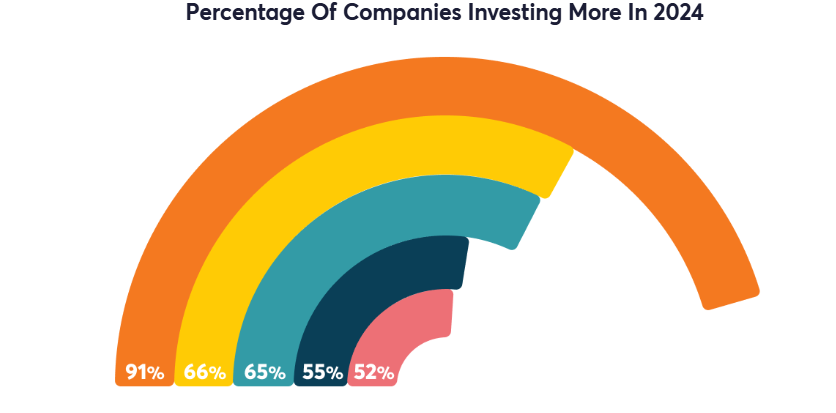
(Source: wellable.co)
General Employee Wellness Statistics
- About 80% of U.S. businesses with more than 50 employees offer wellness programs to help their staff stay healthy and happy.
- Nearly half (51%) of companies with 50 or more workers provide some wellness program.
- Employees who have access to wellness programs are twice as likely to feel grateful and are 40% less likely to feel stressed.
- Financial stress lowers work engagement by 18.2%, showing how important financial wellness is for employees.
- Workers who feel appreciated at work are 20 to 40% less likely to have frequent negative emotions.
- Almost 90% of companies offer at least one wellness benefit to their employees.
- Around 70% of employers have made changes in their workplaces to encourage healthier habits among their staff.
Importance of Wellness Programs to Improve Employee Wellbeing
- The best ways to support employees’ well-being are offering work-life balance (66%) and giving enough time off (50%).
- Suggestions and solutions to improve employee well-being include creating a healthy work environment (41%), offering more wellness resources (39%), and adding more mental health programs (34%).
- A survey found that 87% of employees who work from home are happy with their work, while only 63% of those working full-time in the office feel the same way.
Employee Wellness Program Availability Statistics
- Around 85% of large companies and 54% of small businesses offer at least one wellness program.
- Employee Wellness Statistics show that 51% of employers with 50 or more workers provide some form of wellness initiative.
- Looking ahead to 2024, 45% of organizations plan to increase spending on wellness programs, while 51% expect to maintain their current investment, and only 4% foresee a decrease.
- By 2024, 86% of employers offer mental health support.
- If workplaces had gyms available during work hours, 77% of employees would exercise more.
- Wellness programs benefit businesses, resulting in improved financial growth for 63% of employees and fewer sick days for 56% of workers in these programs.
- Over 40% of companies use incentives like gift cards or lower insurance costs to boost participation.
Impact of Employee Wellness Programs Statistics
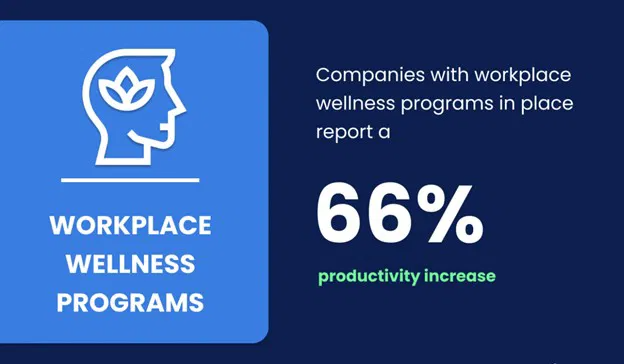
(Source: zoets.b-cdn.net)
- Wellness programs help workers build connections, making them feel ten times more included at work.
- Companies with wellness programs see a 67% boost in employee happiness and a 66% improvement in work efficiency.
- These programs also improve the financial performance of 63% of businesses and reduce employee absences by 50%.
- On the flip side, employees who feel unappreciated at work are 2.5 times more likely to experience burnout.
Type of Employee Wellness Statistics
- By the end of 2024, most companies (91%) are putting more money into mental health support for workers.
- At the same time, 91% of employees feel stressed about money, showing a need for better financial help.
- Around 90% of employers now offer Employee Assistance Programs (EAPs) to support mental and emotional health.
- Based on employee Wellness Statistics, more than half of companies (53%) provide standing desks to encourage better health.
- In the U.S., 76% of workers say job stress hurts their relationships.
- Wellness programs can boost productivity by 20%, proving they are a smart investment for businesses.
Employee Wellness Program Statistics By Frequency
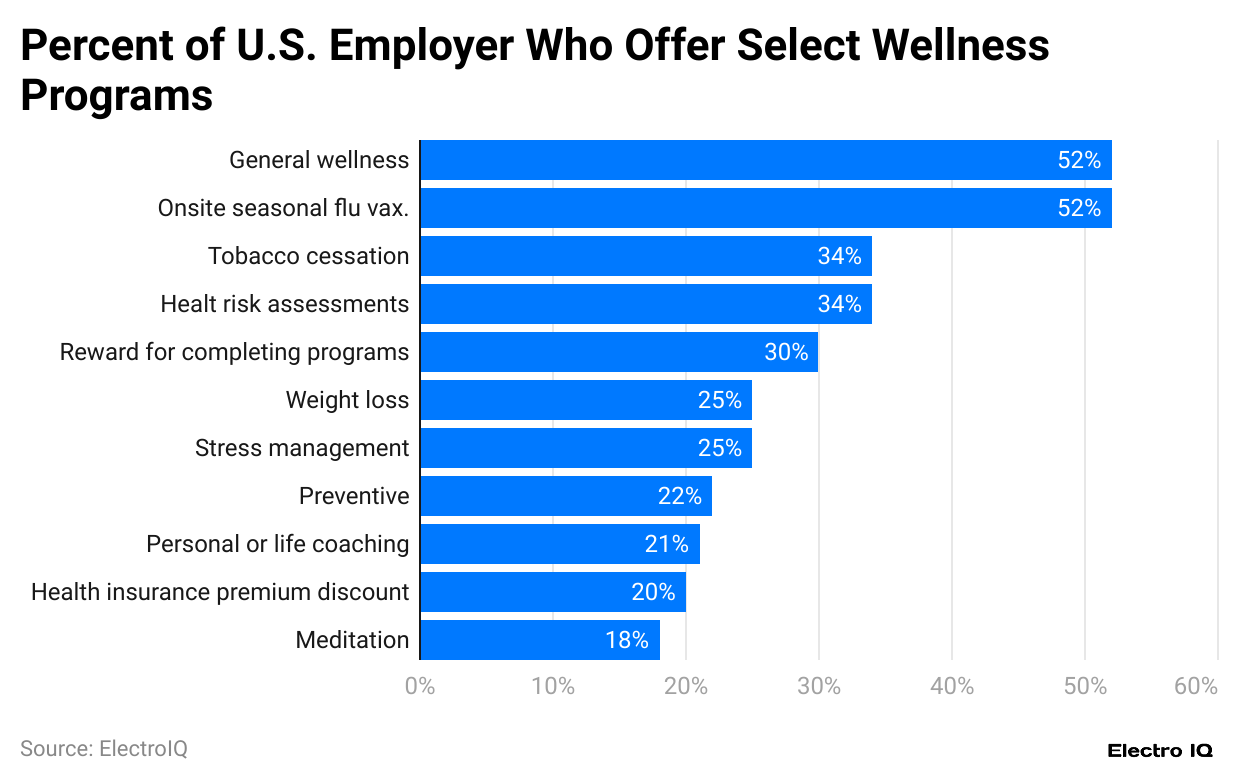
(Reference: zippia.com)
- According to Employee Wellness Statistics, 52% of U.S. companies have provided general wellness programs in recent years and offer on-site flu shots.
- Furthermore, other programs include tobacco cessation (34%), health assessments (34%), program rewards (30%), weight loss (25%), preventive care (22%), life coaching (21%), insurance discounts (20%), and meditation (18%).
By Geography
- Employee Wellness Statistics report that about 60% of workers in North America can use wellness programs.
- Meanwhile, in the U.S., 51% of employers with 50+ employees offer wellness programs.
- In Europe, around 50% of employees have access, with more in Western Europe than Eastern.
- In Asia-Pacific, 35% have access, mostly in developed countries like Japan and Australia.
- In Africa and the Middle East, only 20% benefit.
Employees’ Sense of Wellbeing Statistics By Country
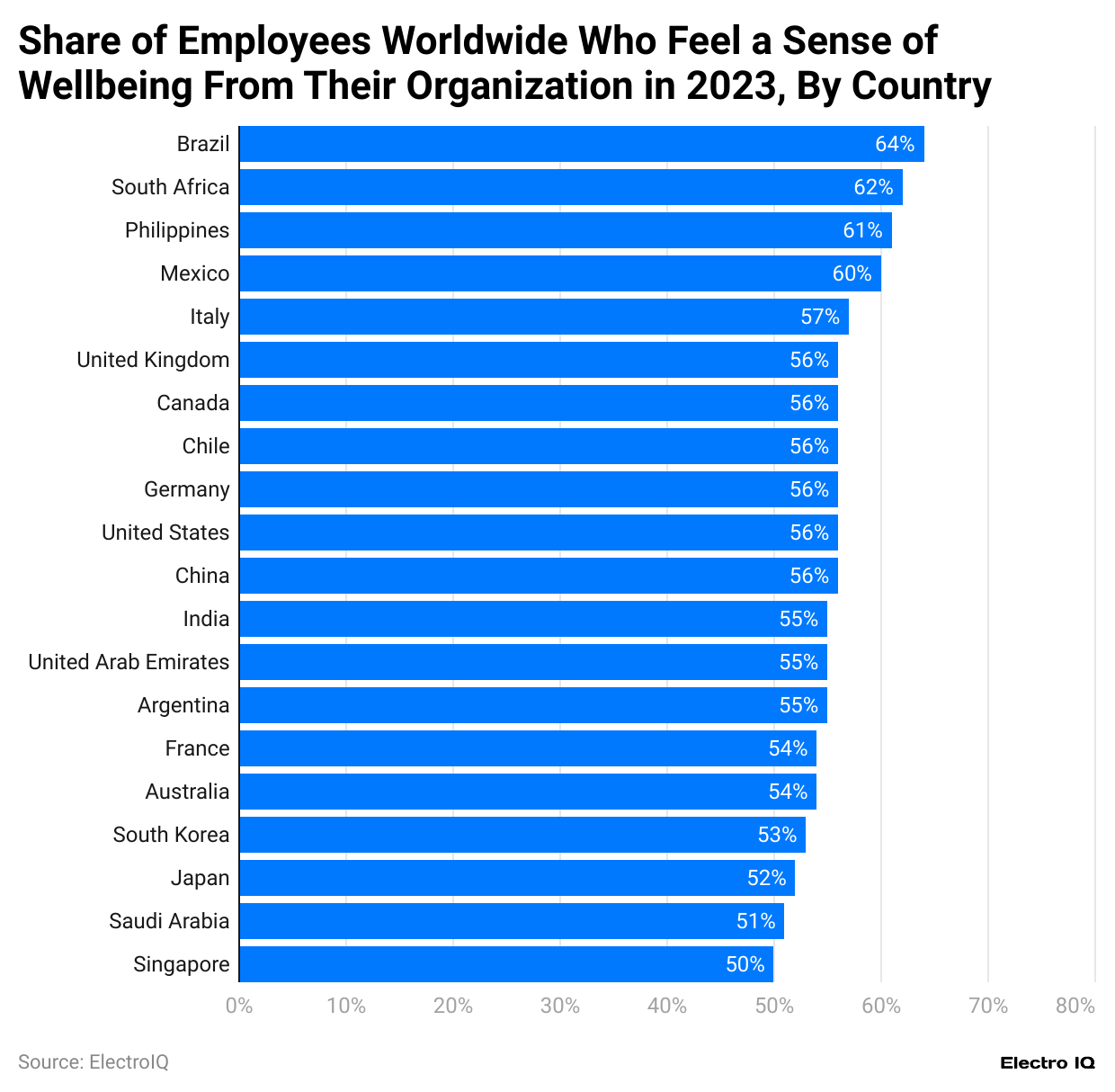
(Reference: statista.com)
- Employee Wellness Statistics show that in Brazil, nearly 64% of workers said they feel good about their well-being at work.
- South Africa is close behind, with 62% of employees sharing the same view.
- The Philippines follows at 61%, while, in Mexico, around 60% of workers are happy with their well-being, while 57% in Italy feel the same.
- Countries like the UK, Canada, Germany, Chile, the USA, and China show 56%, and India, UAE, and Argentina report 55%.
- Furthermore, the share of employees worldwide who feel a sense of well-being is followed by France (54%), Australia (54%), Australia (54%), South Korea (53%), Japan (52%), Saudi Arabia (51%) and Singapore (50%).
Overall Employee Wellness Statistics By Category
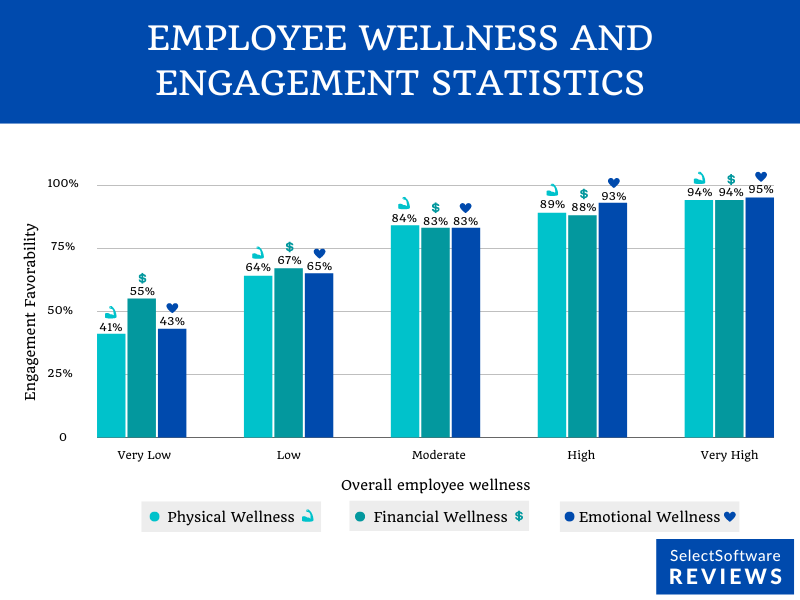
(Source: cdn.prod.website-files.com)
| Engagement Favorability | Physical Wellness | Financial Wellness | Emotional wellness |
| Very high | 94% | 94% | 95% |
| High | 89% | 88% | 93% |
| Moderate | 84% | 83% | 83% |
| Low | 64% | 67% | 65% |
| Very low | 41% | 55% | 43% |
Financial Wellness Platforms for Employees
- The most popular financial employee benefits in 2024 include remote work reimbursements, used by 89% of employees.
- Other top choices are frequent pay options (84%) and PTO exchanges (81%).
- Financial support programs like low-interest loans and mortgage assistance follow closely at 79 to 80%.
Employer Costs for Employee Compensation Statistics By Ownership
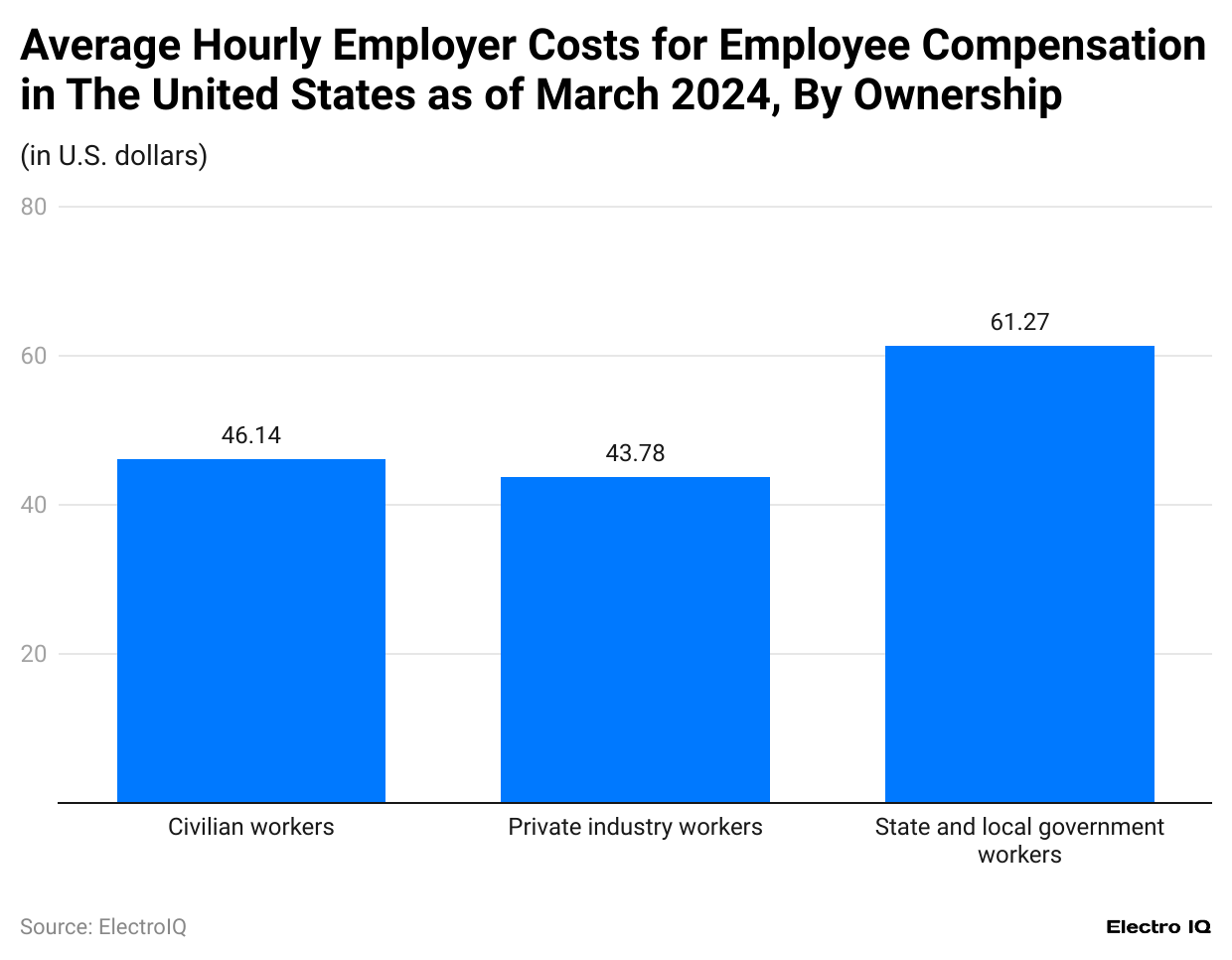
(Reference: statista.com)
- According to a Statista report in March 2024, U.S. employers spent the most on state and local government workers, with compensation averaging USD 61.27 per hour.
- The cost for civilian workers stood at USD 46.16 per hour, followed by private industry workers at USD 43.78 per hour.
By Compensation Components
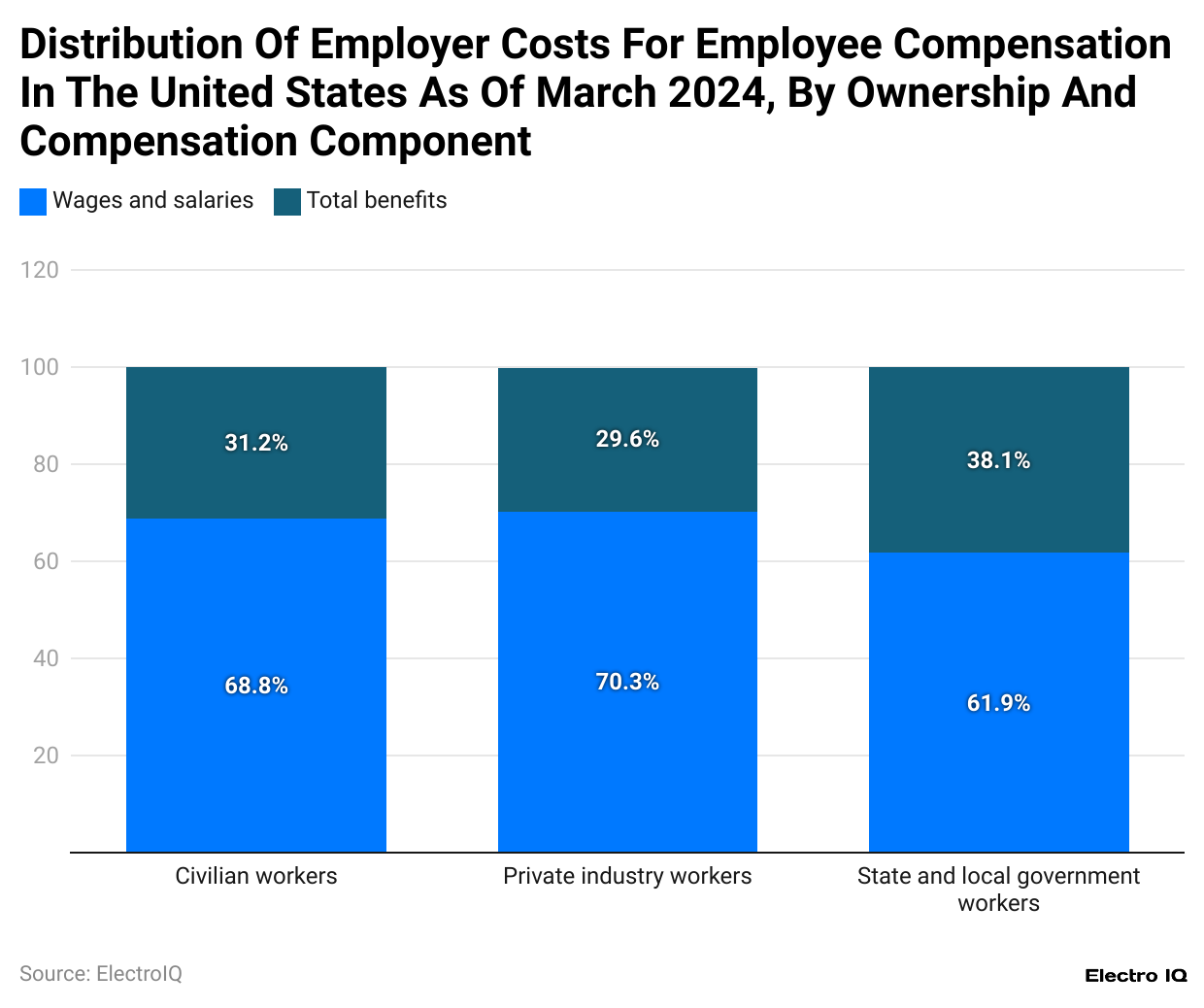
(Reference: statista.com)
- Employee Wellness Statistics show that employers spend the most on benefits in U.S. state and local governments, spending 38.1% of their employee costs on them.
- The remaining 61.9% went toward wages and salaries.
- For Civilian workers: total benefit (31.2%) and wages & salaries (68.8%).
- For Private industry workers: total (29.6%) and wages & salaries (70.3%).
Employee Wellness Investment Statistics
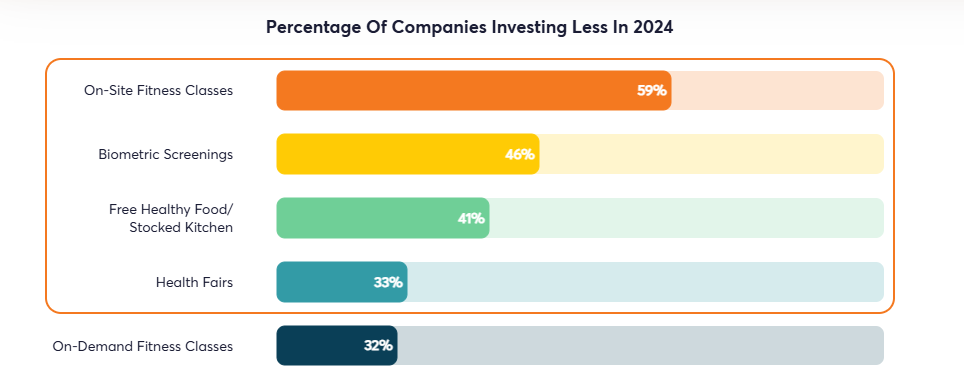
(Source: wellable.co)
- Globally, Employee Wellness Statistics reveal that 59% of companies are reducing traditional and on-site fitness classes.
- Additionally, 46% have stopped offering biometric screenings, and 41% no longer provide free healthy food or stocked kitchens.
- Besides, other wellness benefits seeing reduced investment include health fairs (33%) and on-demand fitness classes (32%).
Employee Participation Statistics in Wellness Programs
- A Forbes report shows that nearly 90% of workers think about the benefits package before deciding on a job.
- A RAND study found that when companies offer incentives, only 20 to 40% of employees join wellness programs.
- Surprisingly, 61% of big employers said financial rewards don’t work well or are only somewhat helpful.
- Based on Employee Wellness Statistics, about 90% of large companies with over 50,000 employees provide wellness programs, though some sources suggest the number is closer to 81%.
- On average, only 40% of employees take part in these programs.
- While 87% of workers have access to mental health resources, only 23% actively use them.
Employee Wellness Programs Statistics By Returns on Investment (ROI) for Organizations
| Metric | Statistics |
| Average ROI |
USD 1.50 to 3 per dollar spent over 2 to 9 years |
|
Absenteeism Cost Savings |
Saved USD 5.82 per dollar spent |
| Healthcare Cost Reduction |
60% of organizations |
|
Productivity Gains |
63% of employers report increased financial sustainability and growth |
| Employee Morale Improvement |
77% of employees |
|
Chronic Disease Management |
Structured lifestyle interventions reduced diabetes incidence by 58% among adults with prediabetes. |
| Overall Savings Example |
Johnson & Johnson saved USD 250 million over a decade through wellness programs. |
|
Employee Engagement |
Over 80% of employees enjoy work when their employer engages in their wellness. |
Benefits of Employee Wellness Programs
- Wellness programs in workplaces show that around 53% of workers feel healthier due to these programs, and 67% noticed they lost weight.
- According to employee wellness statistics, about 30% of illnesses are caught early, thanks to regular health checks.
- These programs also help employees miss fewer days at work, reducing sick days by 56%.
- Job satisfaction has gone up, with 70% of participants feeling happier at work.
- Healthcare costs have dropped for 62% of employees, and companies reported a 25% boost in productivity.
- Over 31% dedicate an hour daily to healthy activities improving lifestyles.
- Some programs even cut diabetes risks by 58%.
- Lastly, 77% of employees believe these programs improve workplace culture and morale, making work more enjoyable.
Employee Wellness Barriers Statistics
- In 2024, around 80% of employees say stress impacts their relationships with family, friends, and coworkers, according to Mental Health America.
- Workplace stress negatively affects 75% of workers, with the most common issues being sleep problems (53%), low morale (43%), and anxiety attacks (37%).
- Many workers (83%) and executives (74%) struggle to meet their well-being goals, often due to work-related challenges.
- About 30% of U.S. workers feel their job harms their mental health, with heavy workloads (30%) and long hours leaving little personal time (27%) being the main causes.
Conclusion
Employee wellness is an essential criterion for creating a happy and productive workplace. When companies prioritize, their employees’ mental and physical health comes first for enhancing better performance, stronger teamwork, and higher job satisfaction. Simple steps like promoting work-life balance, offering wellness programs, and recognizing employees’ efforts can make a big difference.
Healthy employees are more engaged, take fewer sick days, and stay longer with the company. Investing in wellness is a smart move for both employees and businesses.
Sources
FAQ.
Employee wellness programs include fitness classes, mental health support, stress management workshops, healthy eating initiatives, and workplace flexibility options.
Employee wellness boosts productivity by improving focus, reducing stress, and enhancing overall work performance.
Wellness programs often provide a USD 3 return for every USD 1 spent on improving employee health.
Small businesses can offer wellness programs through flexible schedules, fitness activities, and mental health support.
Future employee wellness trends focus on mental health, work-life balance, personalized benefits, and flexible work options.

Maitrayee Dey has a background in Electrical Engineering and has worked in various technical roles before transitioning to writing. Specializing in technology and Artificial Intelligence, she has served as an Academic Research Analyst and Freelance Writer, particularly focusing on education and healthcare in Australia. Maitrayee's lifelong passions for writing and painting led her to pursue a full-time writing career. She is also the creator of a cooking YouTube channel, where she shares her culinary adventures. At Smartphone Thoughts, Maitrayee brings her expertise in technology to provide in-depth smartphone reviews and app-related statistics, making complex topics easy to understand for all readers.










